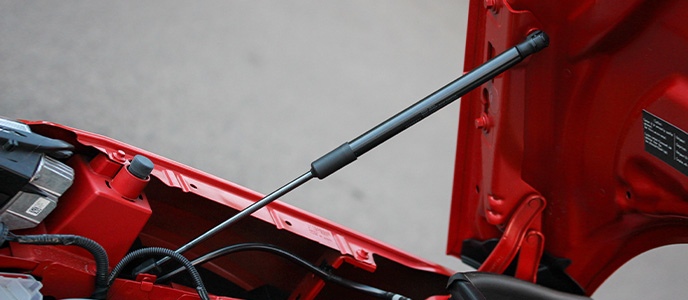5 July 2023
![How to install gas struts on a car]()

Your guide to installing replacement gas struts on your car’s bonnet
If you’ve had your car for a decade or more, chances are your gas struts (or gas stays) are close to the end of their lifespan. Maybe you’ve noticed your car’s bonnet won’t automatically open anymore. Maybe you haven’t noticed they’ve failed at all, but your mechanic told you so at your last servicing.
You can ask your mechanic to replace your gas struts for you. But what they’ll save you in convenience, they’ll charge you in cash. Or you could always replace your car’s gas struts yourself.
The good news is that installing new gas struts is extremely easy, even if you’ve got no experience with the task at all.
In this guide, we’ll give you step-by-step instructions on replacing the gas struts under your car’s bonnet.
We’ve also created a handy downloadable guide for choosing and installing vehicle gas struts.
Browse our vast range of vehicle gas struts to find the perfect replacement struts for your car’s make and model. For other projects, check out our full range of gas struts.
When to replace your car bonnet’s gas struts
There’s nothing as obvious as a failed gas strut — no matter how inexperienced you may be around cars, you’ll notice it the next time you lift your car’s bonnet and find it can’t hold itself up anymore.
If there’s one good thing about failed gas struts, it’s that they’re not so much dangerous as they are irritating. On the other hand, failing gas struts that are weak but haven’t totally given out yet are dangerous — you never know when they might collapse the bonnet onto your head or hands.
You need to replace the gas springs under your car’s bonnet when:
-
The gas stays can no longer hold up the bonnet
-
When you suspect one of the gas stays as failed (this will put undue pressure on the remaining strut, which may be nearing its end as well)
-
After 10 years of use, or whenever your particular gas strut models are nearing the end of their lifespan
Picking the right struts for the job
Making sure you’ve got the correct struts for your needs is a job of its own. Your best bet is to get in touch with us for a recommendation or to come into our store so that we can take a look at your vehicle ourselves.
If you would like to try sizing struts yourself, first have a read of our guide on how to choose the right gas struts for your vehicle.
Tools you need to replace a car’s gas struts
Don’t worry — you won’t need anything fancy.
You’ll need the following:
-
Replacement gas struts
-
Small flat blade screwdriver (or something with a thin flat edge)
-
Ratchet or spanner

Tips for replacing your vehicle’s gas struts
-
If your vehicle has two struts, you should always replace both of them. Replacing just one gas strut could cause twisting due to uneven loading. With two new struts, you’ll have exactly the same pressure for an even lift.
-
You’ll need someone else on hand to help you. They will need to support the hatch, bonnet, boot or rear window while you replace the struts. It can be dangerous to attempt to do so on your own. Avoid injuries, ask a mate!
-
Gas struts must be replaced one at a time. If you are replacing two struts, go at it one at a time.
-
The struts should be installed in the same position as the original units.
-
Struts must always be mounted with the tube up in the closed position. This is vital to proper lubrication and smooth operation.
-
Remember that compressed gas can be dangerous. Never crush or pierce a strut that you’re trying to remove.
Replace your car’s gas struts in 4 easy steps
1. Prop up the bonnet
We can’t have the bonnet collapsing on you while you’re changing out the struts. So, you’ll need to prop it up securely.
Your car will almost certainly be outfitted with a prop rod to hold up the bonnet. To find the prop rod, lift the bonnet up and look for a long metal rod at the very front edge of the car. The prop rod will be hinged on one end, with the other end secured in a clip — simply unclip the rod, stand it vertically, and you’ll see that it aligns with a hole in the bonnet.
If your vehicle doesn’t have a prop rod, we recommend you ask a friend to hold the bonnet open while you work.
If nobody can help, you can prop up the bonnet with a long, strong stick like a broom or a length of wood.
Whatever method you choose, ensure that the bonnet is absolutely secure and that the bonnet is all the way open.
2. Remove the damaged, failed or old struts

The gas stays will be connected to your car at two points:
-
There will be a ball and socket joint connecting the stay to the bonnet itself
-
The connection to the body of the car will also be a ball and socket joint, but the joint will likely be connected to a mounting bracket rather than to the vehicle directly
You’ll need a flat blade, like a screwdriver, to open the ball joints on your gas stays. On the back of the joint's socket (the tip of the gas stay), you’ll notice a thin metal clip — this element holds the ball stud in the socket. Slip the screwdriver beneath the metal clip and gently lever it open. The joint should now easily pop off.
The ball joint attached to the mounting bracket can be opened in the same way. But, if the cramped space makes it a little tricky to find the right angles, use your spanner or ratchet to undo the bracket; that’ll let you access the gas stay joint easier. You can easily screw them back into place with your ratchet or spanner.
3. Attach the new gas struts

The easiest part of the job is attaching your car’s replacement gas struts. We’ve made it easy by marking your ovesco gas struts with arrows that indicate which end of the strut connects to which ball stud.
All you have to do is click the sockets onto the ball studs. Easy as, see?
4. Test the new gas struts and bonnet
While your new struts will now hold up your bonnet, you may notice that they’re a bit stiff when you open and close the bonnet. That stiffness occurs because the new strut rods are still lubricating inside the pressurised chamber. The stiffness will disappear soon enough, but you can help it along by gently lifting and closing the bonnet a few times.
Order your car’s replacement gas struts from ovesco
We hope you feel confident enough to replace your car’s gas struts on your own. If you’re still unsure about any step of the process, maybe our video guide to replacing car gas struts can clear things up for you.
Go ahead and check out our full range of gas struts to find the right components for your project. And don’t hesitate to get in touch for advice.




